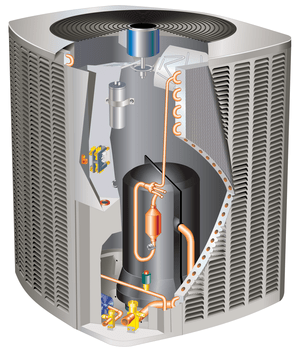If you’re considering adding supplementary heating or cooling to your home, a heat pump can be a great option. The fact that heat pumps don’t require ductwork means they can be installed quickly and easily. Moreover, they can be an excellent source of heating and cooling that is much more energy efficient than most other sources. Nonetheless, it is important that you understand exactly what a heat pump is and how it works to determine if it is a good choice for your needs.
What Is a Heat Pump?
A heat pump is a special type of heating and cooling system that uses electricity and refrigeration technology to draw heat directly from the air or the ground. The most common type of heat pump is an air-source heat pump. Commonly referred to as a ductless mini-split, a heat pump consists of two separate units that work in conjunction to provide both heating and air conditioning. On the outside of the building is a condenser unit that is responsible for creating heating or cooling. A refrigerant line connects the condenser to a wall-mounted air handler inside the building that releases the heated or cooled air.
There are also ground-source heat pumps, which are sometimes referred to as geothermal heat pumps. Instead of drawing heat out of the air, this type of heat pump captures heat either directly from the ground or an underwater body of water.
How Heat Pumps Provide Heating and Cooling
Heat pumps work on the principle of heat transfer, which essentially means they take warm air from one place and transfer it to another. Due to the laws of thermodynamics, heat will always naturally flow from a warmer area, known as the heat source, to a heat sink or lower temperature area. Heat pumps take advantage of this by using refrigerant to transfer hot air from outside the house to the inside or vice versa. However, the process works slightly differently depending on whether the unit is creating heat or air conditioning.
When turned to heating mode, the condenser unit draws heat directly from the outside air. This heat passes over the refrigerant line, which begins warming up the refrigerant. The refrigerant then moves through a compressor, which compresses the liquid coolant into a gas and drastically increases its temperature. The hot gas refrigerant is then pumped into the air handler via the refrigerant line. The heated refrigerant passes into a series of coils inside the air handler. The air handler then forces air over the heated coils, which heats the air as it passes through the unit and into the room. Whenever the unit is turned on, a fan constantly circulates air through the air handler to draw cold air in and push hot air out. This process causes the refrigerant to cool, which is why hot refrigerant is constantly pumped into the air handler and cooled liquid refrigerant is constantly pumped back out into the condenser to be reheated.
Heat pumps work in a similar way when turned to cooling mode but with one major difference. Instead of transferring air from outside the house to the inside, heat pumps transfer air from inside the house to the outside when producing cooling. When set to cooling mode, the air handler draws hot air out from inside the home. The hot air again passes over the refrigerant coils in the air handler. This captures excess heat from the air, which is then pumped outside of the building via the refrigerant line. In cooling mode, the air handler is constantly drawing in hot air over the cooled refrigerant coils, which both captures the heat and cools down the air as it is released from the air handler.
This process is essentially the same as what most central air conditioner units use to provide cooling. In fact, an air conditioner is technically a type of one-way heat pump. An AC unit draws hot air from inside the house into a condenser, which cools the air and then pumps it back into the house. However, the term is usually never used to refer to an AC unit. Instead, the term heat pump is mostly only ever used to refer to mini-splits and other systems that can pump heat from both inside and outside the house.
Ground-source heat pumps work in much the same way. However, instead of extracting heat from the air, these systems usually use a series of refrigerant lines buried underground that extract heat directly from the ground. As the refrigerant circulates through the lines, it captures heat from the ground and then transfers this directly into the building when creating heat.
Benefits of Installing a Heat Pump
One major reason that many people choose to go with a mini-split system is that they are easy to install and require no ductwork. This means that they can be easily installed in any part of your house as long as it has an exterior wall. In most cases, the entire system can be installed within a few hours. This makes them a great choice for adding supplementary heating or cooling or for any areas of the building where there is no ductwork. In addition, they can be a fantastic option for warmer climates where a furnace and central heating system may not always be necessary. This is because they allow you to still heat your home whenever needed without having to spend thousands of dollars to install a central heating system that you’ll only rarely ever use.
Generally, installation involves mounting the condenser unit on a concrete pad outside of the home. Next, a small hole is cut through the exterior wall to accommodate the refrigerant line. Finally, the air handler is installed on the interior wall directly over the hole and then the refrigerant line is run from the condenser to the air handler.
Heat pumps are also extremely efficient, and they require no fuel or other energy source other than electricity. Compared to traditional electric heating options like baseboard heaters, heat pumps are often up to three times as efficient. Where a traditional electric heater produces one unit of heat for every one watt of energy it consumes, a highly efficient heat pump can produce as much as three units of heat for every watt of electricity.
However, the actual efficiency of the heat pump is determined in large part by the temperature of the air outside. It is obviously much more difficult to draw heat out of the air when the outside temperature is much colder. As a result, heat pumps tend to be much more efficient and thus a better choice in areas that typically don’t experience extremely cold winter weather.
At Tarpy Plumbing, Heating & Air, our team specializes in ductless mini-split systems for customers living in San Diego and the surrounding area. We offer a range of high-quality Mitsubishi mini-split units suitable for almost any type of space. Our highly trained HVAC technicians can also assist with any of your other heating and cooling needs, including new furnace or AC installations, maintenance and repair. Contact us today to get more information about heat pumps and mini-splits or to learn about any of our other services.


 SPECIALISTS
SPECIALISTS

